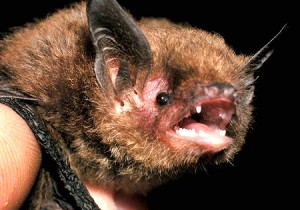by Rae Schnapp, Ph.D.
We need to adopt a very conservative strategy to protect a species of mammal that bears our state name. Here’s why.
Currently, the Indiana Department of Natural Resources (IDNR) Division of Forestry’s (DoF) harvests timber from state forest lands with little monitoring for Indiana Bat (Myotis sodalis). For example, the DoF was unaware of a maternity roost located by IFA’s bat surveys in the summer of 2016. Research indicates that the Indiana Bat prefers interior forest sites, not forest edges as previously reported (see studies by Jeremy J. Sheets in 2013 and James E. Gardner in 1991).
Another reason for concern: in 2005, total population estimates for the Indiana Bat were at about 457,000 — half as many as when the species was first listed as endangered in 1967. And now the Indiana Bat and other bat species are threatened by the deadly White Nose Syndrome, first detected in Indiana in 2011.
Now, the DoF has admitted that its timber sales in Indiana state forests might inadvertently kill the endangered Indiana Bat, so they have requested an Incidental Take Permit. The Endangered Species Act allows this incidental take in exchange for conservation measures, based on an approved Environmental Impact Statement and Habitat Conservation Plan. This provides an opportunity to minimize and mitigate incidental take by monitoring to determine more precisely where Indiana Bat colonies are roosting and foraging so that timber harvest in those areas can be avoided.
Indiana Bats are found in Kentucky, Illinois, Missouri, Michigan and New York, but Indiana is the primary repository of the species, so habitat here is crucial. In exchange for an allowable incidental take of this species, the DoF needs to develop robust monitoring that will identify prime habitat, minimize and mitigate cumulative impacts, and optimize the bats’ recovery. Using the precautionary principle, the EIS should evaluate alternatives that conserve enough Indiana Bat habitat in an unlogged condition to make up for any incidental take.
IFA has commented on the state’s proposed Environmental Impact Statement and Habitat Conservation Plan. Our detailed comments address:
-Current status of the species including new information about roost sites from our Ecoblitz monitoring efforts
-Cumulative impacts of logging in combination with other threats including White Nose Syndrome, wind towers, and transportation corridors
-Quantitative estimates of incidental take associated with planned logging activities
-Identification of roost and foraging locations where logging must be avoided
-Mitigation recommendation that 40% of our State Forests should be set aside from all logging to ensure that no incidental take occurs in these areas
-Robust monitoring is needed to evaluate the success of the species and the effectiveness of mitigation procedures.
Read IFA’s proposed environmental impact statement in its entirety.

